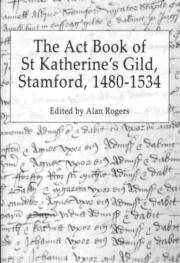The Act Book of St Katherine’s Gild, Stamford, 1480 - 1534
(Stamford Survey Group 2011)(ISBN 978-1-84549-509-1) (£19.95)
The Henrician and Edwardian Reformations not only destroyed much of the fabric of late-medieval
religion, they also ensured the destruction of much of its historical record. That the Act Book of the Gild
of St. Katherine in Stamford survived was entirely due to the collecting instincts of Dr. William Moore, a
seventeenth-century Fellow of Gonville and Caius College, Cambridge, who presented the manuscript to
the College's library, thereby ensuring its survival. We should be grateful, therefore, to Alan Rogers and
his team from the Stamford Survey Group for their considerable effort in transcribing this substantial
document and editing it for publication.
From the point of view of the modern reader the major shortcoming of the Act Book is, as Professor
Rogers acknowledges, that it reveals very little of the religious life of the gild. Gilds and confraternities
flourished in fifteenth-century England, and the cult of St. Katherine, evident in England from the
eleventh century, was widely celebrated. Decline, however, did set in. Membership was reduced by the
late 1520s, the Act Book finishes abruptly in 1534, and there is no record of the gild in the chantry
commissioners' report of 1548. Professor Rogers eschews any speculation about the specific
circumstances of the ending of the gild. At present, therefore, it is impossible to place its demise in the
context of continuing debate about the nature of popular religion during the Henrician Reformation.
On the other hand, the major strength of the Act Book is what it reveals about the social elite of Stamford and its relationship with the
surrounding countryside. The gild lacked the prestige and wealth of Stamford's leading gild, the combined gild of Corpus Christi and St.
Mary. Nevertheless, it did give scope for office holding for the 'second tier' of the town's tradesmen and provided a focus for the
extension of their connections to celebrities of local and national importance, most significantly Lady Margaret Beaufort, mother of
Henry VII. The gild also cultivated links with local clergy in Lincolnshire, Northamptonshire and Rutland. The social basis of its
membership moved upwards during the first decade of the sixteenth century. However, this might have had a detrimental effect on the
gild's core functions, and the gild seems to have experienced some sort of crisis in 1510, from which it did recover before the final
decline set in. This volume certainly represents a significant piece in the rich and complex jigsaw of Stamford's late-medieval religious
and civic culture.
Alan Rogers is hoping that readers of this book might identify some Rutland names, there are many members from Northamptonshire
but few identified as yet from Rutland. If readers are able to identify members from Rutland would they please email the details to him.
Mike Tillbrook

Researching Rutland
Copyright © Rutland Local History and Record Society. - All rights reserved
Registered Charity No 700273


Book Review



Researching Rutland
© Rutland Local History and Record Society
Registered Charity No 700273

Book Review
The Act Book of St Katherine’s Gild, Stamford, 1480 - 1534
(Stamford Survey Group 2011) - (ISBN 978-1-84549-509-1) (£19.95)
The Henrician and Edwardian Reformations not only destroyed much of
the fabric of late-medieval religion, they also ensured the destruction of
much of its historical record. That the Act Book of the Gild of St. Katherine
in Stamford survived was entirely due to the collecting instincts of Dr.
William Moore, a seventeenth-century Fellow of Gonville and Caius
College, Cambridge, who presented the manuscript to the College's
library, thereby ensuring its survival. We should be grateful, therefore, to
Alan Rogers and his team from the Stamford Survey Group for their
considerable effort in transcribing this substantial document and editing it
for publication.
From the point of view of the modern reader the major shortcoming of
the Act Book is, as Professor Rogers acknowledges, that it reveals very
little of the religious life of the gild. Gilds and confraternities flourished in
fifteenth-century England, and the cult of St. Katherine, evident in England
from the eleventh century, was widely celebrated. Decline, however, did
set in. Membership was reduced by the late 1520s, the Act Book finishes
abruptly in 1534, and there is no record of the gild in the chantry
commissioners' report of 1548. Professor Rogers eschews any speculation
about the specific circumstances of the ending of the gild. At present,
therefore, it is impossible to place its demise in the context of continuing
debate about the nature of popular religion during the
Henrician Reformation.
On the other hand, the major strength of the Act Book is what it reveals
about the social elite of Stamford and its relationship with the
surrounding countryside. The gild lacked the prestige and wealth of
Stamford's leading gild, the combined gild of Corpus Christi and St. Mary.
Nevertheless, it did give scope for office holding for the 'second tier' of
the town's tradesmen and provided a focus for the extension of their
connections to celebrities of local and national importance, most
significantly Lady Margaret Beaufort, mother of Henry VII. The gild also
cultivated links with local clergy in Lincolnshire, Northamptonshire and
Rutland. The social basis of its membership moved upwards during the
first decade of the sixteenth century. However, this might have had a
detrimental effect on the gild's core functions, and the gild seems to have
experienced some sort of crisis in 1510, from which it did recover before
the final decline set in. This volume certainly represents a significant piece
in the rich and complex jigsaw of Stamford's late-medieval religious and
civic culture.
Alan Rogers is hoping that readers of this book might identify some
Rutland names, there are many members from Northamptonshire but
few identified as yet from Rutland. If readers are able to identify members
from Rutland would they please email the details to him.
Mike Tillbrook







